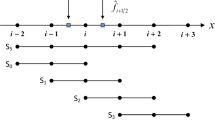Abstract
Screech frequency is predicted using three different approaches, which make use of different quantities measured from the same computed flow field. The three different approaches are based on shock cell spacing in the imperfectly expanded supersonic jet, the wavelength of standing wave formed at the edge of the shear layer due to interference between downstream propagating hydrodynamic instabilities and upstream propagating acoustic waves, and from a spectral analysis of near-field pressure fluctuations. The computed flowfield for underexpanded and overexpanded axisymmetric screeching jets are obtained by solving the unsteady Navier-Stokes equations using a higher order Weighted Essentially Non-Oscillatory (WENO) discretization along with a subgrid scale Large-Eddy Simulation (LES) model.
Similar content being viewed by others
References
Powell A. (1953). On the mechanism of choked jet noise. Proc. Phys. Soc. Lond. 66: 1039–1056
Powell A. (1953). On the noise emanating from a two-dimensional jet above the critical pressure. Aeronaut. Q. 4: 103–122
Raman G. (1999). Supersonic jet screech: Half-Century from Powell to present. J. Sound Vib. 225: 543–571
Panda J. (1998). Shock oscillation in under expanded screeching jets. J. Fluid Mech. 363: 81–116
Panda J. (1999). An experimental investigation of screech noise generation. J. Fluid Mech. 378: 71–96
Panda J. and Seasholtz R.G. (1999). Measurement of shock structure and shock-vortex interaction in under-expanded jets using Rayleigh scattering. Phys. Fluids 11(12): 3761–3777
Norum, T., Seiner J.: Measurements of mean static pressure and far-field acoustic of shock-containing supersonic jets. NASA TM 84521 (1982)
Ponton, M.K., Seiner, J.M., Brown, M.C.: Near field pressure fluctuations in the exit plane of a choked axisymmetric nozzle. NASA TM 113137 (1997)
Rona A. and Zhang X. (2004). Time accurate numerical study of turbulent supersonic jets. J. Sound Vib. 270: 297–321
Li X.D. and Gao J.H. (2005). Numerical simulation of the generation mechanism of axisymmetric supersonic jet screech tones. Phys. Fluids 17: 085105–0851058
Shen H. and Tam C.K.W. (2002). Three dimensional numerical simulation of the jet screech phenomenon. AIAA J. 40(1): 33–41
Smagorinsky J. (1963). General circulation experiments with the primitive equations, part I: the basic experiment. Mon. Weather Rev. 91: 99–152
DeBonis J.R. and Scott J.N. (2002). Large-Eddy Simulation of a Turbulent Compressible Round jet. AIAA J. 40(7): 1346–1354
Shu, C.W.: Essentially non-oscillatory and weighted essentially non-oscillatory schemes for hyperbolic conservation laws. NASA/CR-97-206253 (1997)
Shu C.W. and Osher S. (1989). Efficient implementation of essentially non-oscillatory shock-capturing schemes, 2. J. Comp. Phys. 83: 32–78
Loh, C.Y., Hultgren, L.S., Jorgenson P.C.E.: Near field screech noise computation for an under-expanded supersonic jet by the CE/SE method. AIAA paper 2001–2252 (2001)
Ponton M.K. and Seiner J.M. (1992). The effects of nozzle exit lip thickness on plume resonance. J. Sound Vib. 154: 531–549
Jorgenson, P.C.E., Loh, C.Y.: Computing axisymmetric jet screech tones using unstructured grids. AIAA paper 2002–3889 (2002)
Pack D. (1950). A note on Prandtl’s formula for the wavelength of a supersonic gas jet. Q. J. Mech. Appl. Math. III: 173–181
Panda, J., Raman, G., Zaman, K.B.M.Q.: Under-expanded screeching jets from circular, rectangular and elliptic nozzles. AIAA Paper 97–1623 (1997)
Seiner, J., Manning, J., Ponton, M.: The preferred mode of instability for a Mach 2 jet. AIAA Paper 86–1942 (1986)
Seiner, J., Norum, T., Manning, J.: Aerodynamic aspects of shocks containing jet plumes. AIAA Paper 80–0965 (1980)
Mitchell, B., Lele, S., Moin, P.: Direct computation of sound generated by subsonic and supersonic axisymmetric jets. Report TF-66, Thermoscience Division, Department of Mechanical Engineering, Stanford University, CA, USA (1995)
Author information
Authors and Affiliations
Corresponding author
Additional information
Communicated by K.P.J. Reddy.
Rights and permissions
About this article
Cite this article
Singh, A., Chatterjee, A. Numerical prediction of supersonic jet screech frequency. Shock Waves 17, 263–272 (2007). https://doi.org/10.1007/s00193-007-0110-1
Received:
Revised:
Accepted:
Published:
Issue Date:
DOI: https://doi.org/10.1007/s00193-007-0110-1




